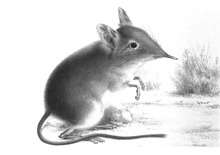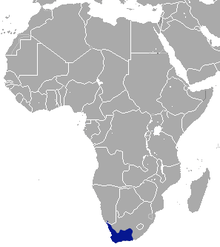Cape elephant shrew
The Cape elephant shrew, Cape rock elephant shrew, or Cape sengi (Elephantulus edwardii) is a species of elephant shrew in the family Macroscelididae. It is endemic to South Africa. Its natural habitat is rocky areas.[2] E. edwardii has been observed to be a non-flying mammalian pollinator of the Pagoda Lily (Whiteheadia bifolia).[3] The Cape elephant shrew uses its long slender tongue to feed on the Pagoda lily's nectar while getting the lily's pollen on its long nose. The Cape elephant shrew is not closely related to other species of shrews and to rodents such as mice. [4]
| Cape elephant shrew[1] | |
|---|---|
 | |
| Scientific classification | |
| Kingdom: | Animalia |
| Phylum: | Chordata |
| Class: | Mammalia |
| Order: | Macroscelidea |
| Family: | Macroscelididae |
| Genus: | Elephantulus |
| Species: | E. edwardii |
| Binomial name | |
| Elephantulus edwardii (A. Smith, 1839) | |
 | |
| Cape elephant shrew range | |
References
- Schlitter, D.A. (2005). Wilson, D.E.; Reeder, D.M. (eds.). Mammal Species of the World: A Taxonomic and Geographic Reference (3rd ed.). Johns Hopkins University Press. p. 82. ISBN 978-0-8018-8221-0. OCLC 62265494.
- Stuart, C.; Perrin, M.; FitzGibbon, C.; Griffin, M. & Smit, H. (2008). "Elephantulus edwardii". IUCN Red List of Threatened Species. 2008.CS1 maint: ref=harv (link)
- Petra Wester, "Sticky snack for sengis: The Cape rock elephant-shrew, Elephantulus edwardii (Macroscelidea), as a pollinator of the Pagoda lily, Whiteheadia bifolia (Hyacinthaceae)", Springer-Verlag, November 16, 2010. Retrieved 2019-04-11.
- Jiang, Jin-Qing; Xia, Xiao-Jing; Wang, Lei; Liu, Chang-Zhong (2018). "Characterization of the complete mitochondrial genome of cape elephant shrew, Elephantulus edwardii". Mitochondrial DNA Part B. 3 (2): 738. doi:10.1080/23802359.2018.1483759.
This article is issued from Wikipedia. The text is licensed under Creative Commons - Attribution - Sharealike. Additional terms may apply for the media files.
